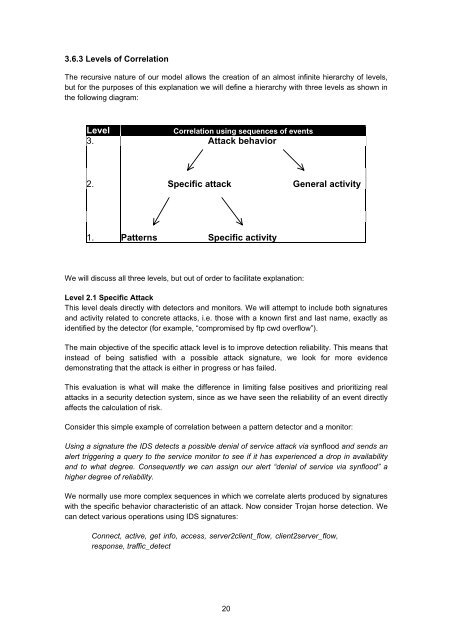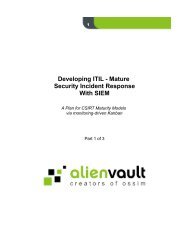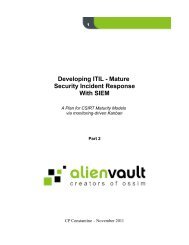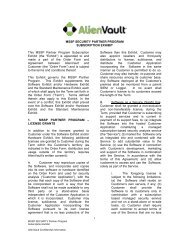ossim - AlienVault
ossim - AlienVault
ossim - AlienVault
You also want an ePaper? Increase the reach of your titles
YUMPU automatically turns print PDFs into web optimized ePapers that Google loves.
3.6.3 Levels of Correlation<br />
The recursive nature of our model allows the creation of an almost infinite hierarchy of levels,<br />
but for the purposes of this explanation we will define a hierarchy with three levels as shown in<br />
the following diagram:<br />
Level<br />
Correlation using sequences of events<br />
3. Attack behavior<br />
2. Specific attack General activity<br />
1. Patterns Specific activity<br />
We will discuss all three levels, but out of order to facilitate explanation:<br />
Level 2.1 Specific Attack<br />
This level deals directly with detectors and monitors. We will attempt to include both signatures<br />
and activity related to concrete attacks, i.e. those with a known first and last name, exactly as<br />
identified by the detector (for example, “compromised by ftp cwd overflow”).<br />
The main objective of the specific attack level is to improve detection reliability. This means that<br />
instead of being satisfied with a possible attack signature, we look for more evidence<br />
demonstrating that the attack is either in progress or has failed.<br />
This evaluation is what will make the difference in limiting false positives and prioritizing real<br />
attacks in a security detection system, since as we have seen the reliability of an event directly<br />
affects the calculation of risk.<br />
Consider this simple example of correlation between a pattern detector and a monitor:<br />
Using a signature the IDS detects a possible denial of service attack via synflood and sends an<br />
alert triggering a query to the service monitor to see if it has experienced a drop in availability<br />
and to what degree. Consequently we can assign our alert “denial of service via synflood” a<br />
higher degree of reliability.<br />
We normally use more complex sequences in which we correlate alerts produced by signatures<br />
with the specific behavior characteristic of an attack. Now consider Trojan horse detection. We<br />
can detect various operations using IDS signatures:<br />
Connect, active, get info, access, server2client_flow, client2server_flow,<br />
response, traffic_detect<br />
20
















